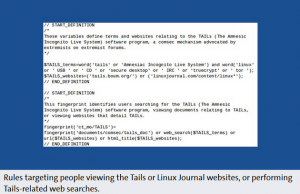Tor Might Be Monitored by NSA
 Trying to avoid censorship, access websites for adults, contact your source for another big article, or protect your location from an abusive partner? NSA has you marked, analyzed and labeled.
Trying to avoid censorship, access websites for adults, contact your source for another big article, or protect your location from an abusive partner? NSA has you marked, analyzed and labeled.
We could try and look at it from the bright side – it might be significantly easier to prove a suspect’s guilt when the prosecutor can use the information that prior to allegedly killing his toddler son by leaving him in the car under the Georgia sun for seven hours straight, the suspect googled for ‘how long does it take for a dog to die in a closed, hot car,’ as reports the Blaze. On the other hand, the Washington Post points out that the predominant majority of Internet users under surveillance are not and will never be actual relevant targets that can lead NSA to terrorism cells.
It’s no surprise NSA wants to know what is under your skin, but if you use Tor, you might make the Big Brother desperate, and that’s when they get mad and start throwing small caliber nets all over the Internet. It’s known for a fact that NSA has been trying to reveal identities of Tor users for years now, and a 2013 leaked report shows utter frustration at continuous failures.
Security researcher Jacob Applebaum and a number of Tor employees and journalists, A. Gibson, J. Goetz, V. Kabisch, L. Kampf, and L. Ryge published an extensive and insightful report in German Das Erste (in English) showing how using or browsing for Tor, and even simply visiting the Tor browser website is considered as a terrorist red flag for the NSA. Three of the authors are Tor employees, and they refer to the NSA XKeyscore database, specifically the source code with rules that lets NSA track people who use Tor and Tails (without finding out where they go while using it, though).
Long story short, the system fingerprints users who simply visit the Tor project website, or simply google for Tails, or browse websites that are known to publish relevant to Tor or Tails information, as well as other services that claim to increase your privacy online, such as MegaProxy, FreeNet, or MaxMinion.
Edward Snowden elaborated on what fingerprinting means in terms of surveillance. These digital fingerprints create a unique identifier for anyone visiting flagged websites or googling for red-flag terms, and include emails used on user computers, user names, phone numbers. This is done via unencrypted connection, when you browse websites broadcasting ads, collecting cookies and other trackers and stats. Further on, analysts can easily associate these unique fingerprints with users’ precise location, unique device ID, their real names, intimate preferences, family members, political or social affiliations and more.
Moreover, it does not require a complex analysis code to mark you as a dormant or active member of any political or social movement, cherry-pick your posts and tweets, and have your activities monitored. All you have to do is be passionate about anything that has to do with national security, and in NSA terms it’s literally everything, while Tor and Tails is bluntly labeled as security means used by extremists.
"Fingerprints are used to identify people who have had the bad luck to follow the wrong link on an Internet site, on an Internet forum, or even to download the wrong file. They've been used to identify people who simply visit an Internet sex forum," he said.
Applebaum’s report derives information from months-long investigation of NDR and WDR, two German television broadcasting companies referring to NSA ex-employees, top secret governmental documents both in Germany and USA.
As noted by Pando Daily, NSA gives Internet users worldwide a simple choice – either follow the rules and stay within the system, or try to hide any metadata and get flagged, scrutinized and singled out for the rest of your life.
My guess is George Orwell knows no peace out there, for he created the scariest science-fiction of all that became true already.
Sources: NDR, The Verge, Pando Daily, Empty Wheel.


